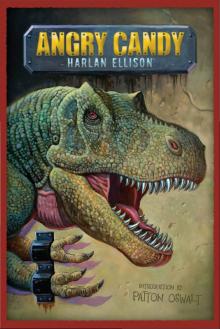- Home
- Harlan Ellison
No Doors No Windows Page 3
No Doors No Windows Read online
Page 3
That is the condition of existence under which we sustain ourselves in this country, tied umbilically to our police. I’m not fool enough to lay it entirely on the police, the crushing responsibility for this fog of uneasiness through which we feel our way, always on edge, always angry, more than a little mad. Police are just postal people, milkmen, sanitation workers. They are employees of city, state and federal government. Only a lunatic would shoot down a mailman. But they are something else. They are representatives of the System. They are the visible fist at the end of the long arm of government, the status quo, order, the establishment need to keep waves from being made. And in an era when big business, the corporate giants, the megalopolitan conglomerates serve their own ends much more ruthlessly than ever they served the needs of the people they no longer even think of as consumers (we are now only “economic purchasing units”), the police find themselves—reluctantly in many cases I’m sure—cast hi the roles of thugs, strike breakers, assassins and harassers for the extruders of plastic, the smelters of ore, the manufacturers of aerosol sprays, the foreclosers and the short-sellers.
Police represent (and in many cases cannot seem to get straight in their heads) not justice, but retribution. Those who were in the dissent movement in the Sixties and early Seventies understand that terrifying fact. They still cling to the naive belief that they work for the Law and the Order, and here in Los Angeles the black-and-whites bear a colophon that reads, “To serve and protect,” yet they no longer assume responsibility (as beat cops used to do) for averting rancor between antagonistic neighbors, for helping drunks out of the gutters to “sleep it off” in a cell till they can be taken home tomorrow, for dealing sympathetically with a woman who has been raped, without asking, “Did you like it?” or “What did you do to encourage him?”
Yes, there are cops like the man who sent that letter you’ve just read, but dig the tone of submerged guilt and misery in that poor guy’s letter. He knows. And why should a man obviously sincerely dedicated to making the world just a tiny bit better, have to feel such pain? Why should he have such a hard time doing the job of easing the anguishes of everyday life for the people he meets? Why do we suddenly totemize and revere the snipers of the S.W.A.T. teams?
The complexity of the problem is staggering. In trying to do a television script for NBC on the uses of psychiatry in prisons, I found myself being drawn off into one convoluted area after another. It isn’t possible to just point the finger at the cops, or the CIA, or Nixon, or the Military-Industrial Complex and heave a sigh of relief. The fear is omnipresent. And it comes from a realization that we are the villains. And even that’s too easy a platitude. I wrote in the introduction to one of my books that they are the Bad Guys: the ones who throw Dr. Pepper cans in the bushes; the ones who get their back bumper tapped at a stop light and scream whiplash; the ones who hate all kids, or all adults, or all blacks, or all whites, or all rich, or all poor; the ones who won’t come to the aid of someone screaming in an alley; the ones who are “only doing their job” and can’t break or bend the pointless rules. They are the Bad Guys.
And I must have received a thousand letters telling me I had no right to wash my hands of the human race; I had no right to say fuck’m and stop fighting for “the cause” (whatever the hell that is); I had no right to point the ringer at them and exclude myself.
Clearly, my readers did not understand the message. As the old Midwestern saying goes, “When you point a finger at someone else, you point three at yourself.” I agree. I’m one of them, so are you. We’re all the villains, the Bad Guys, the fear-makers. That part in each of us, even the noblest and most self-sacrificing of us, that forgets or fears or avoids or rationalizes and permits evil to flourish. We are all Jekyll and Hyde. And I wrote that introduction to say that we are permitting Mr. Hyde to dominate us more and more each day. Just like cops. Just like preachers. Just like humanitarians and school kids and politicians. How can you fight the fight against that evil, except in yourself?
Yes, I have the right to become a misanthrope, to decide the human race doesn’t have the stuff to make it, that it won’t last one-thousandth the life-span of the great saurians, because seemingly the human race doesn’t give a damn. And one fights only as long as one has the fiber strong enough to fight; after which, one tries to simply get through the days. And no, I haven’t really given it all up, as the writing of this introduction shows, because I’ve never learned (like Ross Macdonald’s Lew Archer) to “give it up and quit gracefully.”
But what is one to say in the face of a letter like the one from that cop? Can we possibly beat the Hyde in each of us and defeat the fear that gags us like an evil fog?
Perhaps. But probably not. We seem determined to go on this way till we either reduce ourselves to barbarians or make “civilized” existence so unbearable that crime and the suicide rate claim us before we taste the simplest joys.
I don’t have the answers for anyone but myself.
Perhaps you have some of the answers.
If so, apply them.
And then, perhaps, one day soon, guys like that cop will be able to sign their names to letters as potent and meaningful as the one you just read.
Religion won’t get it, dope won’t get it, letting Congress do it; won’t get it, only caring and education will do it.
Or, as Louis Pasteur put it, “Chance favors the prepared mind.”
I’ve gone on too long. Conversation, the rap, still holds top spot in my catalogue of ways to have a good time. But I’ve rambled and digressed, and I’ve got to tell you a few things about how some of these stories came to be written, and then I’ll get my face out of your way and let you go on to read the entertainments. Excuse me if I lecture. I don’t mean to. It just comes over me sometimes.
In the main, most of these stories were written in the early and mid years of my writing career. I went through about 300,000 words of previously published (but never collected) stories to select these sixteen. I like each one of them, or they wouldn’t be here. But I’ve substantially rewritten all of them. The errors of style and grammar I made when I was learning my craft were so silly and awful, I couldn’t bear to let them stand. So in many ways these are new stories. Two were written for this book, just a few months before you bought the book.
Only one of these stories has ever appeared in a collection before, “The Whimper of Whipped Dogs.” I include it here, even though it’s available in the recently-published DEATHBIRD STORIES, because it is the most prominent of my suspense stories, and comes with the cachet of the MWA award I mentioned earlier in this introduction. Besides, it’s only 8000 words long, out of a total wordage in this book of almost 77,500. (This introduction is over 12,200 words long, a major chunk of work, as essay material intended for collections goes; or merely another example of The Mouth That Doth Run Off. Who knows…?) As a matter of fact, it occurs to me that some of you may be curious as to the way word-lengths are computed, and how a sufficiency of material is gathered together for a collection. Well, most paperbacks contain about 60,000 words, if they’re original novels of ordinary length, or collections of stories. So you’re getting quite a package for your money. Using typewriter margins set at 12 on the left and 73 on the right (good margins are necessary for the eyesight and sanity of editors, proofreaders, typesetters and even authors correcting dumb mistakes they made when they were in their twenties), using pica type—elite is too small—most writers average out between 250 to 300 words a typewritten page. I use 260 as a figure to even things out where there are stories with a lot of dialogue, which takes up less space. So that means a twelve-page story (typed, that is) will run 3000 words. Sixteen pages is a 4000 worder. And so on. The accepted categories of story lengths are: short story—anything under 7500 words; novelette—at least 7500 but less than 17,500 words; novella—from 17,500 to 40,000; novel—anything of 40,000 words or higher. These are the generally accepted length and category judgments, as adhered to by, for instance, the Science F
iction Writers of America when classifying stories for the Nebula Awards.
To carry this helpful bit of public service data to its logical conclusion, for those budding authors among you who never had anyone lay such necessary but primitive information on you, as I discuss each story, 111 insert its wordage in square brackets. Don’t thank me, just don’t send me your stories to read…I’ll only burn them.
“The Whimper of Whipped Dogs” [8000] is based on the murder of Kitty Genovese, about which I’ve nattered in books like THE DEADLY STREETS [Pyramid V3931]. The case is now so famous, it’s obsessed me for eleven years since it happened. Woman knifed to death in the streets of New York’s Kew Gardens section while thirty-eight people watched from their windows, heard her screams for help, did nothing, turned up their tv sets so the screams wouldn’t penetrate. It took the rapist-killer over half an hour to slice her up as she dragged herself around almost a full city block. They could have saved her. They didn’t. I was never satisfied with the intellectual theories about why no one had aided her. It’s not the kind of dehumanized behavior that can be explained with phrases like “disinvolvement” or “alienation” or “inurement to the reality of violence from seeing so much death on nightly newscasts.” It was the kind of mythic situation that could only be explained in terms of magic realism, fantasy.
“Eddie, You’re My Friend” [1300] is a rarity. It’s an unsold story. I’ve written over 800 short stories and articles and essays and suchlike in my twenty years behind this machine, and with only one or two exceptions—dogs that embarrass me even to look at, which I’d fight to the death against letting appear in print—everything has sold to one magazine or another. But when I went through my files to put this book together, and read all those old stories, and picked only the best, I found “Eddie” and remembered it, and smiled and liked it. It’s not a particularly thoughtful story, just a little one-punch blowdart, but it worked, so I added it to the book. But when I went to locate the source of first publication, to enter it on the acknowledgment page where copyrights are listed, I couldn’t find any mention of its having been published. I consulted the exhaustive and elegant bibliography of my work assembled by Leslie Kay Swigart, but even she had no mention of the story. And I realized I’d assumed that story had been published, all these years. But it hadn’t. It was, in effect, a brand-new, unpublished yarn. And it appears here for the first time. (Unless, in the five and a half months between the time I write this page, and NO DOORS, NO WINDOWS is published, I manage to sell it to a magazine, in which case it will still be a new story as far as book publication is concerned.)
There isn’t much to say about “Status Quo at Troyden’s” [4600]; it speaks for itself. Except to say that if there was one reason why I wanted a book of my suspense fiction to get between covers, it was to preserve for “posterity,” or whatever, this one story. I don’t know why I’ve always thought highly of it, but I like it enormously. I think it has a lot of heart, and it was an early indication of where my interests and writing abilities were going. So now Mr. Huggerson and Harry Troyden and Mr. Zeckhauser will have some extended life since they appeared in a long-gone mystery magazine in 1958.
“Nedra at f:5.6” [3100] is one of those cases of literary cross-pollination that people looking to misinterpret your actions could label plagiarism. I’ll head them off at the pass by copping to it in front. Back in the late Forties, 1949 to be exact, even before I’d “discovered” science fiction, I was intrigued by, and bought, a 25¢ paperback titled THE GIRL WITH THE HUNGRY EYES. (Yes, Virginia, in those days all paperbacks were 25¢ and it was such an accepted thing, that the book doesn’t even have a price on it; everybody just knew.) That was a remarkable little paperback. Historically as well as personally for me. It was the very first original collection of sf/fantasy stories. That is, the contents was not made up of culls from magazines or other books, but were stories commissioned especially for that book. The publisher was Avon Books (#184), the editor was the indefatigable (and still going strong) Donald A. Wollheim, now a publisher himself with his line of DAW paperbacks; and it contained six excellent stories never-before-published by William Tenn, the late P. Schuyler Miller, Frank Belknap Long, Manly Wade Wellman, the late August Derleth writing under the name Stephen Grendon and, author of the title story, “The Girl with the Hungry Eyes,” the master of us all, Mr. Fritz Leiber.
Well, the story blew me away. I won’t tell you what it was about, you can find it reprinted in…
Holy Jesus! I just went and checked my four foot shelf of everything Fritz Leiber has ever written—no self-respecting writer in our time would dare to set pen to paper without having studied the master in toto—and I find “The Girl with the Hungry Eyes” has never been reprinted in a Leiber collection in this country. I see it in an English edition called THE SECRET SONGS, but of the twenty or so Leiber collections that have gone on the racks of America’s newsstands, not one of them has included that superb fantasy. Yes, I know it was done on television on Night Gallery a few years ago, but that’s ephemeral, and they made mush of it, anyway. What I’m trying to say here is that even in the recently released Ballantine collection called THE BEST OF FRITZ LEIBER, that story isn’t available. Now that’s bloody disgraceful!
I pulled out my battered, mildewed (literally mildewed) copy of the Avon paperback, and the same thrill I got when I read Fritz’s chilling fantasy twenty-six years ago, I got a minute ago, holding that poor little battered Avon edition. In short, what I’m getting at, is that the story stayed with me, in tone and in general concept, until 1956, when I sat down and wrote a variation on the idea, and called it “The Hungry One” and added beneath the title, “An homage to Fritz Leiber.” It was published in a slick men’s magazine in that year, sans the dedication to Fritz, and it’s been reprinted in lesser magazines maybe a dozen times since, but I’ve never had it in a book under the title it now has, nor has it ever managed to get into print with the respectful homage addressed to Fritz that was on it from the first. But I’ve rewritten it for this book, I’ve reinstated the credit line, and though I know it isn’t one one-millionth the story Fritz’s was, it is a way of saying thank you to a writer whose life’s writing has not only influenced mine, but has touched virtually every fantasist working in the genre today.
And if you hit the used paperback stores from time to time, keep your eyes open for that moth-eaten Avon paperback. Or maybe somebody will hip Peter Mayer at Avon to include it in his “Science Fiction Rediscovery” series.
“Opposites Attract” [4000], “Toe the Line” [4000], “Pride in the Profession” [4100], “The Children’s Hour” [2350], “Two Inches in Tomorrow’s Column” [2300] and “Ormond Always Pays His Bills” [1800] are simple, uncomplicated crime and/or suspense stories with a gimmick at the end. A snap in the tail. O. Henry time. They don’t need any frills. I wrote them for money, in the days when I was writing a lot of stories as fast as I could because (as today) I loved writing more than anything including sex, and I had (as today) more ideas than my two-finger typing (as today) could keep up with. “The Children’s Hour” is a kind of sf story, I suppose, but it’s just a variation on the Pied Piper idea. They were written to provide entertainment and I doubt very much that any of them will alter the course of Western Civilization. But I hope you like them.
“Down in the Dark” [4000] and “The Man on the Juice Wagon” [7500] are action-adventure stories with the emphasis on danger and suspense. They were written for men’s magazines and I found when I re-read them, and wanted to include them, that I had to change the ending to “Juice Wagon” completely to eradicate the stench of male chauvinist rancidness that I, and those magazines, subscribed to in them there unenlightened days. I suppose the men’s magazines still consider women toys to play with, but, like an Alcoholics Anonymous convert, I has seen de light, and I find that treating women as human beings, in my personal life as well as hi my stories, makes for a better, richer, more intelligent life…and the same for the stor
ies. Both “Dark” and “Juice Wagon” are based on experiences in my checkered past. To some small degree.
“White Trash Don’t Exist” [6000] has one element stolen from Steinbeck’s OF MICE AND MEN. You’ll spot it right off. That’s okay. It isn’t stealing, it’s, uh, er, research. (What was it Rodin was supposed to have said, quoting Michelangelo? Oh, yeah. “Where I steal an idea, I leave my knife.”) The interesting thing about “White Trash” is that when I first wrote it, for the Manhunt market of the mid-Fifties, a market that used tough, brutal crime stories without even a hint of traditional detective material in it, I called it “Niggers Don’t Exist” and I intended it as a statement about life for blacks in areas of the South I’d passed through. The editor loved the story, but wouldn’t buy it with blacks in it, so I rewrote it using “white trash.” I was hungrier to sell in those days. That was before I got hip to Bob Heinlein’s 5 rules for a writer, and before I added two of my own.
So when you read “White Trash,” you can replace whatever elements this introduction compells you to replace.
What’s that? Oh, I see. I’ve teased you with Heinlein’s and my rules, so the least I can do is digress again and give them to you. I’d be a rat not to do it, wouldn’t I?
Well, never let it be said that a sweetie like me made his readers angry. God knows I’ve never antagonized any of you. Okay, here they are:
1. You must write.
2. You must finish what you write.
3. You must refrain from rewriting except to editorial order.
4. You must put it on the market.
5. You must keep it on the market until sold.
ROBERT A. HEINLEIN, 1947
6. Only accept the last four words of rule 3 if your integrity and the quality/interior logic of the story reconcile with such changes. Otherwise:

 Repent, Harlequin! Said the Ticktockman
Repent, Harlequin! Said the Ticktockman Broken Glass
Broken Glass Other Glass Teat
Other Glass Teat Memos From Purgatory
Memos From Purgatory I Have No Mouth and I Must Scream
I Have No Mouth and I Must Scream The Deadly Streets
The Deadly Streets The Glass Teat
The Glass Teat Paingod and Other Delusions
Paingod and Other Delusions No Doors No Windows
No Doors No Windows Strange Wine
Strange Wine Harlan Ellison's Watching
Harlan Ellison's Watching Over the Edge/An Edge in My Voice
Over the Edge/An Edge in My Voice Troublemakers: Stories by Harlan Ellison
Troublemakers: Stories by Harlan Ellison Gentleman Junkie and Other Stories of the Hung-Up Generation
Gentleman Junkie and Other Stories of the Hung-Up Generation The Kyben Stories
The Kyben Stories From the Land of Fear
From the Land of Fear The Top of the Volcano: The Award-Winning Stories of Harlan Ellison
The Top of the Volcano: The Award-Winning Stories of Harlan Ellison Sleepless Nights in the Procrustean Bed
Sleepless Nights in the Procrustean Bed Ellison Wonderland
Ellison Wonderland Children of the Streets
Children of the Streets Can & Can'tankerous
Can & Can'tankerous Love Ain't Nothing but Sex Misspelled
Love Ain't Nothing but Sex Misspelled Stalking the Nightmare
Stalking the Nightmare Approaching Oblivion
Approaching Oblivion Deathbird Stories
Deathbird Stories Partners in Wonder
Partners in Wonder Web of the City
Web of the City Spider Kiss
Spider Kiss A Boy and His Dog
A Boy and His Dog Shatterday
Shatterday Slippage: Previously Uncollected, Precariously Poised Stories
Slippage: Previously Uncollected, Precariously Poised Stories Repent, Harlequin! Said the Ticktockman
Repent, Harlequin! Said the Ticktockman Come to Me Not in Winter's White
Come to Me Not in Winter's White The Song the Zombie Sang
The Song the Zombie Sang The Other Glass Teat
The Other Glass Teat Doomsman - the Theif of Thoth
Doomsman - the Theif of Thoth The City on the Edge of Forever
The City on the Edge of Forever I See a Man Sitting on a Chair, and the Chair Is Biting His Leg
I See a Man Sitting on a Chair, and the Chair Is Biting His Leg The Harlan Ellison Hornbook
The Harlan Ellison Hornbook Pulling A Train
Pulling A Train The Glass Teat - essays of opinion on the subject of television
The Glass Teat - essays of opinion on the subject of television An Edge in My Voice
An Edge in My Voice Angry Candy
Angry Candy Troublemakers
Troublemakers The Top of the Volcano
The Top of the Volcano Over the Edge
Over the Edge Survivor #1
Survivor #1 Slippage
Slippage